| 1 | The sky island rattlesnake |
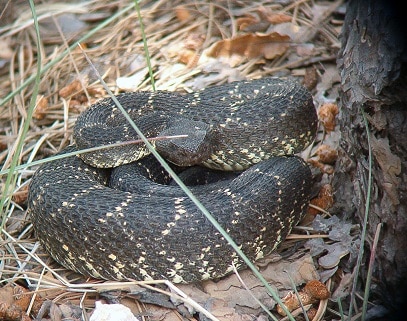
Of the 32 North American rattlesnakes, Crotalus cerberus has two specialities: being extremely black, and living at high altitude. This species has only a narrow range, occupying mainly Arizona, and also far western New Mexico, where their only population is in the Gila Wilderness. Within Arizona, they’re only found north of the busy Interstate 10 highway that bisects the entire state. The thing that differentiates this rattlesnake is its liking for “sky islands”: rugged mountainous realms where they lord it over all other species, towering far above the surrounding deserts.
This snake climbs as high as 2743 metres, in places like the Catalina and San Francisco (Arizona) mountains. Finding them at low elevations is rare, with one of the lowest colonies being Tonto National Monument in the northern Sonoran desert, at 914 metres.
Arizona black rattlesnakes are part of the western rattlesnake complex – closely related to the Pacific and prairie rattlesnake, yet separated into their own species in 2009, confirming what everyone had always suspected. Somehow, evolution pushed them back to these mountainous islands and they stayed there forever. Arizona black rattlesnakes are far more distantly related to tiger and west diamondback rattlesnakes, despite their close proximity. Those two share the same Arizona range, but there’s an extremely clear dividing line between them. While C. tigris and C atrox slither around the dry lower mountain slopes, they suddenly disappear at 1500 metres, and the Arizona black rattlesnake takes their place.
| 2 | Requires cool, mountainous forests |
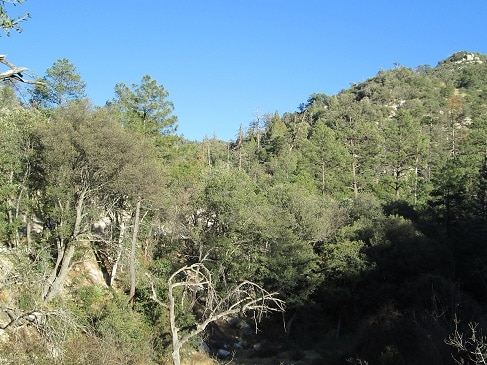
The Arizona black rattlesnake stays well away from arid habitats, and a fully fledged sand desert would rapidly kill them. Instead, their mountainous islands are cool and forested places with pristine air, often in National Parks away from prying eyes. Arizona black rattlesnakes dislike any human development, and stick to the forest wildlands. They live in forests like juniper, ponderosa pine, and especially oak, but also shrubby chaparral adjacent to those forests.
At the highest altitudes, they sometimes appear on rocky slopes, since there’s less need for shelter against the sun. If you’re at an official national park campsite on a mountain road, then there’s little chance of one coming to say hello. Your best bet is to find the deep, winding trails, and glance around you on all sides.
This rattlesnake is often found by fallen woody debris with small boulders nearby. Logs and stumps are sometimes their homes, and flowing mountain streams tend to attract them. In other words, this snake likes your classic rugged mountainous forests, with an added Arizona flavour. Crotalus cerberus craves moisture, and while they’re not quite vampires, they stick to shaded areas and avoid the full blasting sun. Another thing they require is volcanic rock outcrops with deep fissures, as these provide their hibernation dens.
| 3 | The most communal snake ever? |
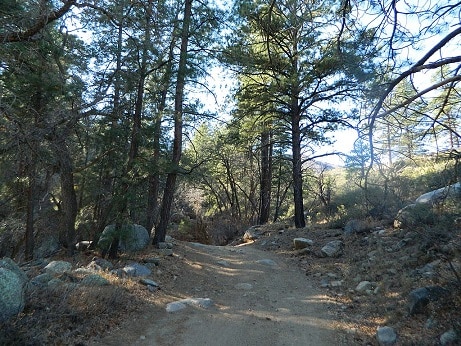
Crotalus cerberus is quite specific in its hibernation dens. Forget mammals burrows; this rattlesnake rests in dense, basaltic volcanic rock. They also form communal dens, with numerous Arizona black rattlesnakes gathered in one dark crevice. Its possible to see one large, black adult coiled up with a tiny brown one slotted in the middle. They seem to have personalities, as they’re selective about which fellow snakes they associate with.
Like many rattlesnakes, this is a species to practise mate guarding. We don’t know whether they sit on their rocks and watch the sunset together, but males will protect their females with a fury. When humans approach, the male will drape itself over the female and shake its rattles loudly, issuing a clear warning to back off. Likewise, the mother protects its babies. They give birth to live young, ranging from 2-11, and the mother will remain with the babies until their first skin shedding. This takes place at 7-14 days old.
Mothers will often gather outside their winter dens to give birth communally. Mating, on the other hand, has never been observed in these communal dens (there would probably be an outcry). Instead, they have secret snake spots away from prying eyes. There’s a whole rattlesnake civilisation in the Arizona mountains with its own codes and rules.
| 4 | Jet black and starry white |
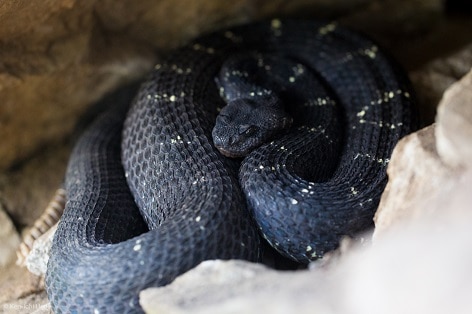
Despite their name, Arizona black rattlesnakes don’t get their pitch black privileges until they age. As youths, they go through the rite of passage of being a dull brown-grey, with more complex patterns on their body. Youths also possess a pair of blotches on their head. Over time, the black scales gain pace and absorb all patterns in their path, until all that remains is a few white patches contrasting against the darkness, like a clear starry night. However, not all adults are pitch black. Those in northern Arizona sometimes keep their brown colouring, particularly females. The further south, the more complete the blackness.
They average at 90cm, and over 1 metre isn’t exceptional. The longest officially documented Arizona black rattlesnake measured 121.9cm, and another measured at least 111.2cm. The smallest length a female can breed at is 50cm.
Those on the highest mountaintops tend to be shorter, as they’re active for as little as 5 months of the year. The colder, windier weather forces them into their hibernation dens in September, not peering out until late April. This simply gives them less chance to eat and balloon up.
| 5 | A weak rattlesnake venom |
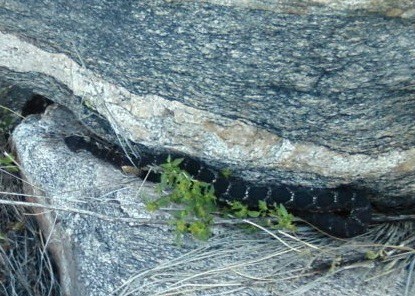
The western diamondback bites 10 people every year, but being so remote, the Arizona black rattlesnake doesn’t have a single confirmed bite. Nevertheless, its venom has been tested in a laboratory on mice. Crotalus cerberus is part of the 7-strong western rattlesnake group, and its venom proved to be the weakest, with an LD50 rating of just 5.54mg. The strongest was the midget faded rattlesnake (0.36mg), while the prairie rattlesnake was middling at 1.55mg.
The toxin profile revealed all, as the Arizona black rattlesnake had the greatest amount of metalloproteases. These are shock and awe toxins, which cause mass destruction of the bonds linking proteins, including necrosis of the skin. Metalloproteases are believed to predigest small prey like mice. Meanwhile, the midget faded rattlesnake (Crotalus concolor) had few metalloproteases, but an abundance of serine proteases. These are far more lethal, as they’re involved with haemostasis, targeting fibrogenin and unleashing blood chaos, whether gushing blood from tiny wounds or blood clots in arteries.
Overall, the Arizona black rattlesnake is one of the mildest rattlesnakes around. If you’re being pursued by tiger rattlesnakes through the desert, then the mountains above you may be a safe haven.
| 6 | Rarely travels long distances |
When Arizona black rattlesnakes emerge in April, they don’t rev into high gear immediately. They laze around by the den entrance for a few days, and their next move is a spring skin shedding (edysis). During this vulnerable period, they move to the shelter of a forest boulder or fallen log.
A few weeks post emergence, the crusty old skin is removed, their eyes stop being blue, and they’ve become a fresher, leaner rattlesnake ready for action. They finally set off for their summer hunting areas. However, a difference is that Arizona blacks rarely travel far from their winter dens. Prairie rattlesnakes go on epic voyages for 5 miles across the plains, and return in November, but Crotalus cerberus will hang around, and sometimes slither past their dens in mid-summer. They’re very faithful to their dens, and return to the same ones for years (the prairie rattlesnake is the same).
Despite this, Arizona black rattlesnakes operate in a home range 3 times larger than its Pacific rattlesnake relative. This was estimated at 27.3 hectares for males, with females significantly less at 2-3 hectares.
| 7 | Changes colour in mere minutes |
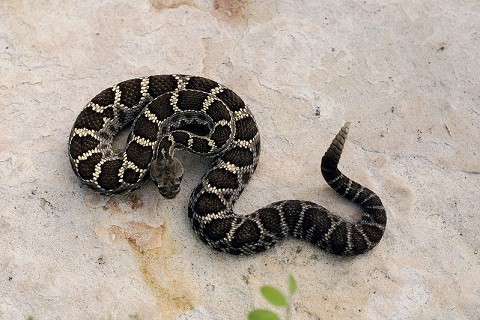
Arizona black rattlesnakes are famous for their rare ability to change colour at will. The cells responsible are called melanophores, located in the epidermis, the scales’ outmost layer. They contain melanin, the same pigment responsible for dark skin in humans. When in grey form, the melanin condenses at the centre of the cell. When the need for blackness arises, the melanin will disperse outwards. These melanophores are found in other rattlesnakes, but the change isn’t as vivid as in the Arizona black.
This blackening (or lightening) process isn’t a reaction to sunlight, but is actually controlled by the snake, a weapon it can initiate at any time. There’s a vague correlation between darker colours at day and lighter by night, but this isn’t consistent. Crotalus cerberus will lighten when attacked by other animals, or captured and restrained by humans. They tend to lighten after a successful hunt, and the shift from black to grey can take place in mere minutes. Not only does it become grey, but the complex patterns of its youth returns, which were lingering below the surface all along.
| 8 | Wildfires and climate change |
Arizona black rattlesnakes dislike human development, staying away from visitor centres and trails. However, they mainly live in national parks, and have some protection. Instead, the main problem is climate change. Being attracted to cool and moist habitats will restrict their habitat ever further in the years to come, while tiger rattlesnakes carry on the same as ever.
A study found that wildfires are a serious problem, as if a forest uncontrollably burns only once every 5 years, the small mammal population dies en masse and barely recovers. These mammals need a healthy upper story and plant life below to thrive, and their demise is predicted to hit the rattlesnake’s food supply hard. It was already estimated that wildfires had reduced the forest niche of Crotalus cerberus by 27% up to 2016. The study put the Arizona black rattlesnake on an “extinction trajectory”, and recommended that they be listed as threatened.
By living in isolated mountain ranges which are separated by the plains between, Crotalus cerberus has a poor ability to colonise new horizons. With global warming, they could be forced higher and higher up the mountains, until they’re stranded in a tiny area at the very top with no helicopter coming to rescue them. In 2014, scientists projected that the Arizona black rattlesnake’s range could fall by 46% by 2099.
| 9 | Uncharted New Mexico |
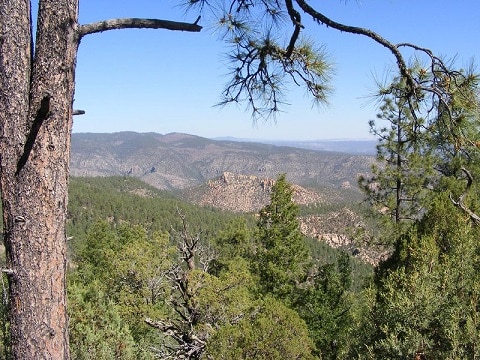
In 2019, scientists decided to check up on the Crotalus cerberus colonies in New Mexico. Unfortunately, being an elusive species, the rattlesnakes didn’t show up according to the scientists’ timetable. In the San Francisco river valley, where they were supposedly abundant, they didn’t locate a single snake. The scientists believed that the habitat was healthy enough that they probably did still exist.
They also journeyed to Mogollan creek and Steeple rock, where sightings were scientifically documented in the 1970s. No Crotalus cerberus were found. It was a ghost town, despite the habitat seemingly being acceptable. They did, however, find rock rattlesnakes and black-tailed rattlesnakes in Mogollan creek. Meanwhile, the scientists discovered two new locations for the Arizona black rattlesnake: Hell Roaring Mesa and SA Creek. These were 4.8 and 9.6 miles further northeast of the previous known range respectively.
The expedition was a mixed bag, as the snake was elusive one minute and greeting them like an old friend the next. To this day, the colonies in New Mexico are much poorer mapped out compared to Arizona.
| 10 | Diet: mammals, lizards and birds |
Crotalus cerberus hunts by day in its idyllic high altitude habitats, using both ambush and active searching. Compared to a flat featureless plain, it has plenty of obstacles to take advantage of, like fallen branches, rocks and forest undergrowth.
Unlike the red diamond rattlesnake, which eats 91.6% mammals, no study has been published on the precise dietary makeup of C. cerberus yet. However, it seems to be a generalist, as dozens of different species have been documented across the mammal, reptile and bird kingdoms. In the Apache-Sitgreaves National Forest of Arizona, they’ve been seen eating American robins while lurking in thickets.
They can apparently eat large meals, as one 8 gram newborn was seen eating a 9 gram plateau fence lizard (Sceloporus tristichus). They eat quails, and one time, a Gambel’s quail fell out of the sky dead, in a canyon the Arizona black rattlesnake was known to frequent. The quail’s body had two puncture marks. Its mammal prey includes the white-throated woodrat, cactus mouse, and Harris’ antelope squirrel.
